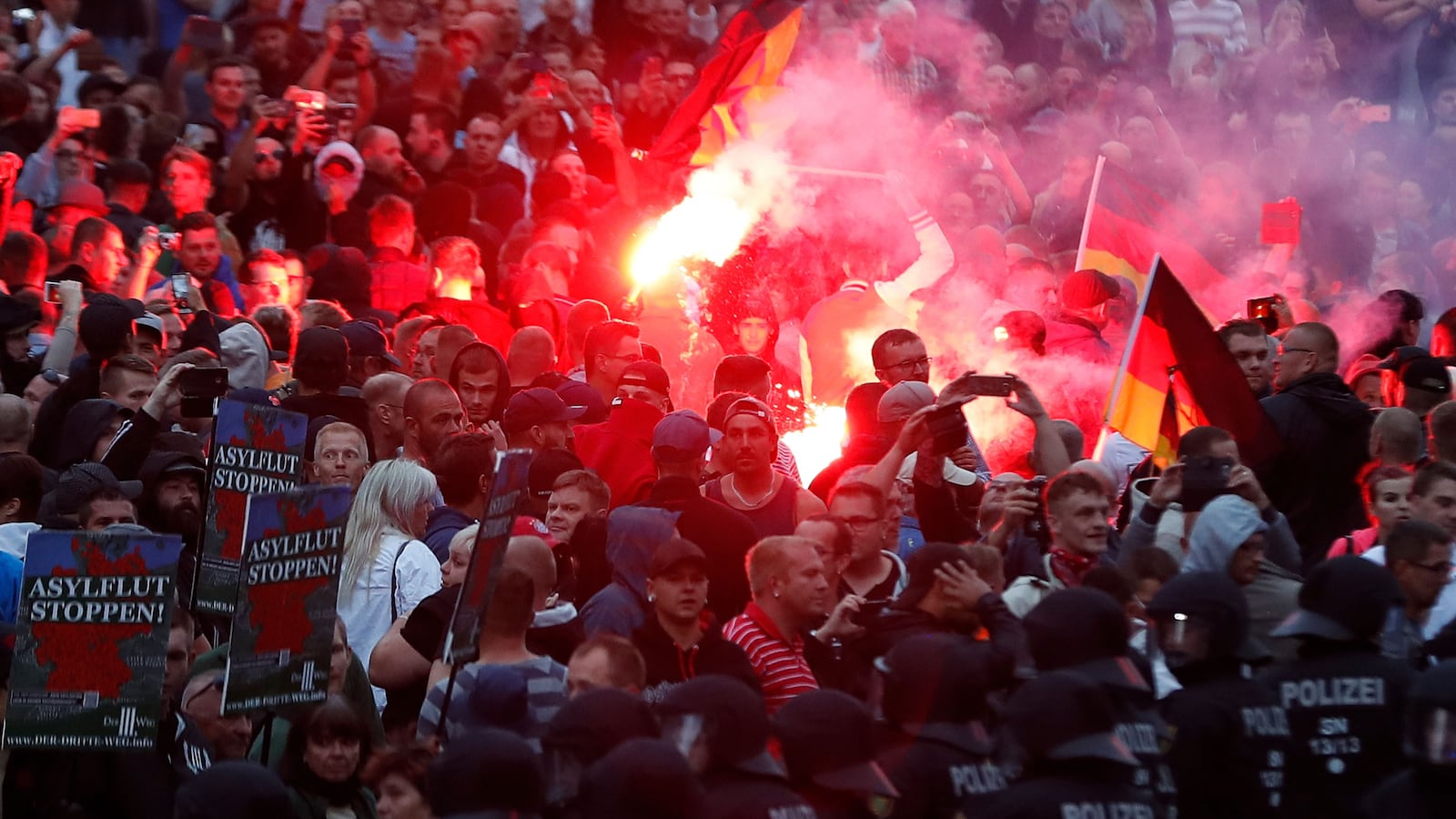A leftist art collective in Germany said they were launching a project to identify neo-Nazi rioters. In reality, it was a hoax to trick neo-Nazis into outing themselves.
This summer unleashed a wave of violence in Chemnitz, Germany, where far-right extremists chased down immigrants and threw fascist salutes during a multi-day rally. Nazi-era salutes are illegal in Germany, but most demonstrators evaded arrest and identification. But the art group Center for Political Beauty (abbreviated as “ZPS” in German) wanted to unveil the extremist networks behind the riots. They built a website that claimed to have identified the Chemnitz rioters. Then they sat back and waited while extremists started searching the site for their own names until ZPS revealed the stunt on Wednesday.
“We thought about a new de-Nazification in Germany and how it could work,” Philipp Ruch, ZPS’s artistic director, told The Daily Beast.
ZPS is part art collective, part activist hub. The group specializes in public awareness performances like coordinating funerals for migrants who died on the way to Germany, and building an enormous replica Holocaust memorial outside a far-right leader’s home.
After the Chemnitz riots, ZPS started collecting footage of rioters and matching them with their public social media profiles.
“They created this atmosphere of fear among the citizens there,” Ruch said of the riots, which took place in the region where he grew up. “They menaced foreigners, and also the press… They hunted people. The whole country was in shock.”
Ruch likened it to the Charlottesville, Virginia white supremacist riot in 2017.
Eventually ZPS identified approximately 1,500 of the estimated 7,000 far-right marchers, Ruch said. But they wanted more names, and more information on the political networks behind the protests. (The riots have been fueled by far-right German Facebook pages, and by established far-right political parties like Alternative for Germany or “AfD.”)
ZPS set up a website with pictures of the 1,500 rioters they’d identified, but visitors to the site could only see 20 pictures at a time. So frantic fascists went to the site’s search bar to see if they’d been named.
“The first thing they’re doing is using the search function on the website to input their own name, or somebody they know, but who nobody else knows, in order to see if this website really works,” Ruch said, “to see if it’s really possible that we identified 1,500 people.”
The site received a traffic boost after a far-right website linked to it, Ruch said. ZPS built a map of names that appeared in the same users’ searches. From those searches, alone, they learned the names and associates of approximately 25 rioters they hadn’t previously identified.
“What we got was quite a network of who knows who, and who else was in Chemnitz,” Ruch said.
U.S. anti-fascists have pulled similar stunts. This summer, undercover activists cozied up to the organizers of a far-right march, and offered to make a website and coordinate T-shirt orders for the event. The website, which did not charge for T-shirts, asked participants for their names and addresses, supposedly to calculate shipping costs. Instead of sending free T-shirts, the activists behind the website published the names and addresses they received.
ZPS’s performances have previously landed it on far-right extremists’ hit lists. In April, German police arrested a soldier who was suspected of planning far-right terror attacks, which he allegedly wanted to blame on refugees. The man also reportedly kept a list of leftist figures he wanted to murder, among them ZPS affiliates.
A September investigation into the alleged would-be-terrorist revealed a larger ring of suspected extremism among Germany’s military elite. Germany’s FOCUS magazine reported that the criminal investigation had uncovered a network of far-right soldiers and officers planning for apocalyptic violence on “Day X,” when they would take over the country.
“It’s terrifying, but I don’t want to live in a country where I can’t do radical political art,” Ruch said. “We need to know who this is, who finances it, who the driving forces are.”






